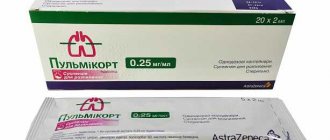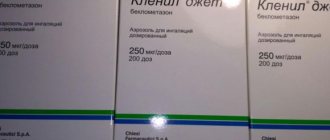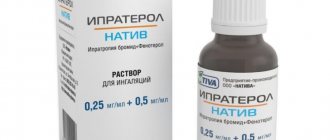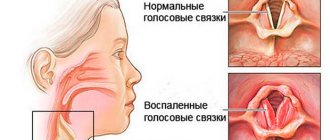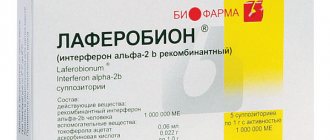Release form and composition
The drug is available in the form of a dosed suspension for inhalation: finely dispersed, almost white, practically odorless (2 ml in polyethylene ampoules, soldered together in the form of a block, 5 soldered ampoules in laminated foil, in a cardboard pack of 4 or 12 blocks and instructions for use of Budenit Steri-Neb).
Composition per 1 ml of suspension:
- active ingredient: budesonide – 250 mcg or 500 mcg;
- auxiliary components: sodium chloride, citric acid monohydrate, polysorbate 80, disodium edetate, sodium citrate dihydrate, water for injection.
Pharmacological properties
Pharmacodynamics
Budesonide, the active substance of Budenita Steri-Neb, is a glucocorticosteroid that has a pronounced local anti-inflammatory and antiallergic effect.
Main effects of budesonide:
- increased production of lipocortin, which is an inhibitor of phospholipase A2;
- inhibition of arachidonic acid release;
- inhibition of the synthesis of prostaglandins and leukotrienes;
- reduction of inflammatory exudation and cytokine production;
- inhibition of macrophage migration;
- reducing the severity of infiltration and granulation processes;
- inhibition of the release of inflammatory mediators from mast cells (immediate hypersensitivity reaction);
- the formation of a chemotaxis substance (this explains the effectiveness of Budenit Steri-Neb in delayed-type hypersensitivity reactions);
- restoration of the patient's sensitivity to bronchodilators, which allows reducing the frequency of their use;
- reduction of swelling of the bronchial mucosa, mucus production, and sputum formation;
- reduction of airway hyperresponsiveness;
- increased mucociliary transport.
Budesonide is well tolerated during long-term treatment and does not have mineralocorticoid activity.
After inhalation of one dose of the drug, the onset of the therapeutic effect is observed after a few hours. The therapeutic effect reaches its maximum in 1–2 weeks.
Budesonide effectively prevents the occurrence of attacks of bronchial asthma of physical exertion, but it does not stop an acute attack of bronchospasm.
Pharmacokinetics
Budesonide is rapidly absorbed after inhalation. In adults, systemic bioavailability after administration of the substance via a nebulizer is approximately 15% of the total prescribed dose. The maximum plasma concentration in the blood is 3.5 nmol/l, the time to reach it is 30 minutes after the start of inhalation.
The substance binds to plasma proteins at a level of 85–90%. The volume of distribution is 3 l/kg.
Biotransformation of budesonide occurs in the liver with the participation of microsomal enzymes, mainly the CYP3A4 isoenzyme. The main metabolites are 16-α-hydroxyprednisolone and 6-β-hydroxybudesonide. They are practically devoid of biological activity (compared to budesonide, 100 times less).
Excreted in the form of metabolites: by the kidneys – 70%, through the intestines – 10%. Systemic clearance of inhaled budesonide and metabolites is 0.5 and 1.4 l/min, respectively. The half-life is 2–2.8 hours.
Features of therapy for certain categories of people
Hormonal medications like Budenit are prescribed very carefully to certain categories of patients. We are talking about children, pregnant women and nursing mothers
During pregnancy
Prescribing Budenit to a pregnant woman or a young mother who is breastfeeding is possible only in case of emergency. In this case, the doctor prescribes the minimum effective dosage.
Since there have been no clinical studies examining the effect of this medication on the composition of breast milk, it is extremely rarely prescribed to women during lactation. If there is an urgent need for therapy with Budenit, a young mother is advised to stop breastfeeding.
Children
The use of this hormonal drug by infants under six months of age is strictly prohibited
For young patients under the age of twelve, the medicine is prescribed by the doctor with great caution and careful calculation of the dosage.
For children suffering from severe bronchial asthma, the medication is prescribed in a dosage of 0.25 mg twice a day (up to the age of three) and from 0.25 to 0.5 mg twice a day (up to the age of twelve). In the case of false croup in a child, the maximum daily dose is no more than 2 ml.
During inhalation treatment, parents are advised to be vigilant and study the growth indicators of their child. If they do not reach the norm, a specialist will need to adjust the dosage downward.
Budenit Steri-Neb, instructions for use: method and dosage
Budenit Steri-Neb is used by inhalation. Inhalations are carried out using special inhalers-nebulizers.
For severe bronchial asthma, as well as against the background of dose reduction or withdrawal of oral glucocorticosteroids, Budenit Steri-Neb is prescribed in the following doses:
- children over 12 years of age and adults (including elderly patients): initial dose – 1–2 mg twice a day, maintenance dose – 0.5–4 mg per day;
- children aged 6 months to 12 years: initial dose – 0.25–0.5 mg twice a day, maintenance dose – 0.25–2 mg per day.
If the daily dose of the drug does not exceed 1 mg, it can be taken once.
The maintenance dose is selected individually. When the desired effect is achieved, it is necessary to reduce the maintenance dose to the minimum effective dose, at which there are no symptoms of the disease. For adults and adolescents over 12 years of age, the lowest effective dose is 0.5–1 mg twice daily; for children aged 6 months to 12 years, 0.25–0.5 mg twice daily.
In cases where it is necessary to increase the therapeutic effect, it is recommended to increase the dose of Budenit Steri-Neb rather than combining inhaled and oral glucocorticosteroids, as this reduces the risk of developing systemic side effects of budesonide.
For stenosing laryngotracheitis, Budenit Steri-Neb is prescribed to children over 6 months at a dose of 2 mg per day at a time or 1 mg in two doses with an interval of 30 minutes.
Budenit Steri-Neb cannot be administered using ultrasonic nebulizers. The required dose of inhaled glucocorticosteroid and inhalation time may vary, depending on the type of nebulizer used (chamber volume, filling volume, air flow rate). To inhale the drug, use an appropriate nebulizer, mouthpiece and face mask. The necessary air flow is created by an air compressor to which the nebulizer is connected. Before use, you must read the instructions for the specific nebulizer model.
Inhalation procedure:
- Prepare the nebulizer for use based on the manufacturer's instructions.
- Separate the ampoule with the sterile solution from the common block of 5 ampoules.
- Break off the cap, holding the ampoule in a vertical position with the cap facing up.
- Squeeze the contents of the ampoule into the nebulizer chamber.
- Carry out inhalation according to the nebulizer manufacturer's instructions.
After finishing the inhalation, you should rinse your mouth with water, and if you used a mask, then rinse your face with water. Discard any unused solution remaining in the nebulizer chamber. Rinse the nebulizer.
During inhalation, avoid contact of the solution with the eyes.
How to do inhalations in a nebulizer
Inhalation procedures are carried out using compressor nebulizers; the use of ultrasonic inhalers is prohibited. The amount of inhaled GCS and the duration of the procedure depend on the model of the inhalation device.
It is best if the inhalation chamber has a valve device. Such a device will increase the effectiveness of treatment by inhaling a larger volume of Budenite.
Before carrying out the actual inhalation, it is necessary to perform the following sequence of actions:
- assemble the device in accordance with the description provided in the operating instructions;
- take the ampoule, the cap should “look” up;
- unscrew the cap and pour the suspension into the inhalation chamber;
- If necessary, add saline solution there.
- After you have prepared the drug, you can proceed directly to the treatment process.
Remains of the medicinal mixture must not be reused and must be disposed of.
After completing the inhalation procedure, it is necessary to rinse your mouth, face, mask, and the inhalation device itself with water.
Side effects
Budenit Steri-Neb may cause the following side effects:
- often: dryness of the oral mucosa, hoarseness, dryness and irritation of the pharyngeal mucosa, unpleasant taste, candidal stomatitis, cough;
- rarely: nausea, thinning of the skin or bruising, esophageal candidiasis, urticaria, rash, bronchospasm, contact dermatitis, angioedema, headache, depression, excitability, behavioral disturbances, nervousness.
With long-term treatment with large doses, systemic side effects may occur (cataracts, glaucoma, adrenal suppression, decreased bone mineral density, growth retardation in adolescents and children), but the likelihood of their development is much lower than with the use of oral glucocorticosteroids.
Budenit Steri-Neb contains disodium edetate in an amount of 0.1 mg/ml. When the concentration of disodium edetate is more than 1.2 mg/ml, bronchospasm may develop.
Inhalation therapy may cause paradoxical bronchospasm and increased dyspnea after drug administration. If a reaction is severe, alternative treatment should be prescribed.
When using a nebulizer with a mask, sometimes irritation of the facial skin occurs, so after the inhalation procedure it is necessary to rinse the facial skin with water.
Budenit's analogs
Quite a lot of solutions for inhalation therapy are produced based on budesonide. These include:
- Pulmicort;
- Budesonide;
- Apulein;
- Benarin;
- Tafen Novolizer;
- Pulmax, etc.
Thus, the analogs Budenit and Budesonide are one and the same. Therefore, in the absence of one of them in a particular pharmacy, it is allowed to purchase the available drug without losing the effectiveness of the treatment. To
special instructions
Budenit Steri-Neb is not intended to relieve attacks of bronchial asthma. To relieve acute bronchospasm, it is recommended to use short-acting inhaled bronchodilators.
In patients not receiving glucocorticosteroids, the therapeutic effect when using Budenit Steri-Neb for inhalation occurs within 10 days. In case of excessive secretion of mucus in the bronchi, it is first recommended to carry out 2 weeks of additional treatment with glucocorticosteroids for oral administration. After a course of oral treatment, in most cases it is possible to completely avoid taking glucocorticosteroids orally.
When transferring a patient from oral glucocorticosteroid therapy to inhaled budesonide treatment, the patient's condition should be relatively stable. For about 10 days, Budenit Steri-Neb is used in combination with oral glucocorticosteroids in usual doses, then their dose is gradually reduced to the lowest. In most cases, complete replacement with an inhaled glucocorticosteroid is possible.
If symptoms of systemic glucocorticosteroid deficiency occur (nausea, vomiting, headache, fatigue), a temporary increase in the dose of oral glucocorticosteroid is sometimes required.
In children receiving Budenit Steri-Neb for a long time, it is recommended to monitor growth indicators. In case of growth retardation, the dose of the drug is adjusted to the lowest level at which effective control of asthma is observed.
Rinsing your mouth with water after each inhalation reduces the likelihood of developing fungal stomatitis.
Impact on the ability to drive vehicles and complex mechanisms
Budenit Steri-Neb does not affect the patient’s ability to drive vehicles or work with potentially dangerous equipment, however, if rare side effects from the nervous system develop, it is recommended to exercise caution when performing such work.
Summarizing
Most often, the result of treatment becomes noticeable immediately after the end of the first inhalation with the suspension: the attack is relieved, breathing becomes easier, wheezing stops.
The effectiveness of treatment directly depends on the regularity of taking Budenit and compliance with the prescribed dosage.
Previous
Preparations for inhalation How often can inhalations with saline be done for children and adults
Next
Preparations for inhalationInhalation with Berodual and saline: how to do it, proportions
Drug interactions
Itraconazole, ketoconazole and other inhibitors of the CYP3A4 isoenzyme may increase the plasma concentration of budesonide (for inhaled use there is no information on such interaction).
Inhaled beta-agonists dilate the bronchi and improve the entry of Budenite Steri-Neb into the respiratory tract, which leads to an increase in the therapeutic effect of the drug.
Estrogens and methandienone increase the effect of budesonide, and rifampicin, phenobarbital and phenytoin reduce its effectiveness.
The drug can be mixed with isotonic sodium chloride solution and other solutions administered via nebulizers (salbutamol, acetylcysteine, terbutaline, ipratropium bromide, fenoterol and sodium cromoglycate).
Contraindications
Hormonal medicine is not prescribed if you have an individual intolerance to one or more components of its chemical formula.
Caution should be exercised when taking Budenita Steri-Neb to people with:
- liver cirrhosis;
- tuberculosis;
- bacterial and viral infections of the respiratory tract;
- exacerbation of chronic renal failure;
- endocrine pathologies;
- cardiovascular diseases.
The use of glucocorticosteroids during pregnancy and breastfeeding is possible only in the minimum pharmacologically appropriate dosage and after prior consultation with a doctor.
